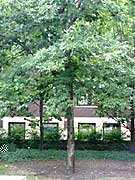


Home
Flowers &
Indoor Plants
Fruits & Nuts
Ornamentals
Vegetables
Special Topics
Resources
Glossary

|
Hickory Nut Carya sp. (car-ya) 




Click on thumbnails for larger image. |
 |
What about it? There are many different types of hickories. The pecan (Carva illincensis) is the only commercially important species but all other hickories produce nuts. These include the shagbark hickory (C. ovata), the mockernut (C. tomentosa), the shellbark (C. lacinosa) the pignut (C. labra), and the bitternut hickory (C. cordiformis). The early white settlers of the Atlantic States noticed the Indians gathering and storing hickory nuts in large quantities in the fall, and using them for food during the winter months. As white settlers began to settle in this country, forests were cleared away and the hickory was used for its timber. The superior timber produced by the hickory was often used in the making of farm implements. The hickory was, therefore, sought out in preference to other trees. What is it used for? In earlier times hickory nuts were crushed to pieces and boiled in water. The most oily part of this mixture was referred to as "hickory milk" and was used as an ingredient in cooking. Today the timber of the hickory nut tree is used in the making of furniture. Nuts are used in many recipes or enjoyed alone. Where does it grow? How do we grow it? A moist, deep soil is preferable for the growth of hickory nut trees. All species of the hickory are readily grown from nuts gathered when ripe and planted within a few weeks. They may be mixed with sand and light soil and buried in the open ground for the winter, and planted the following spring. When planting, place the nuts 3 or 4 inches apart in shallow trenches with 2 or 3 feet between each row. What are its primary problems? The most common insects found on the hickory include the hickory-twig girdler that chews a ring around the twigs, the painted hickory borer, the hickory-bark borer, and the hickory-shuck worm. Anthracaose and various other leaf spots, blotches, and scabs can affect hickory leaves. How do we harvest and store it? Trees will need up to 10 years before they begin to fruit. Pick nuts and store in a dry place.
© Copyright, Department of Horticulture, Cornell University. |